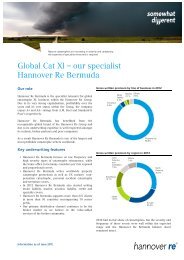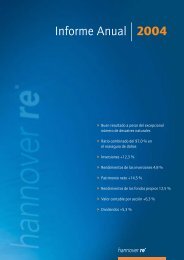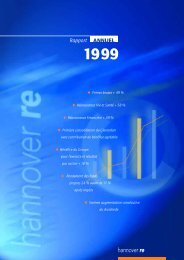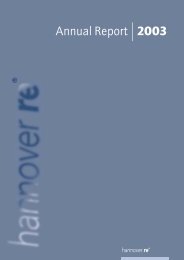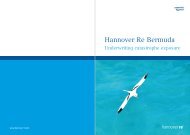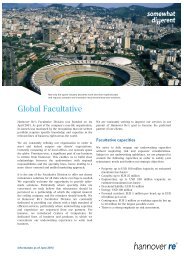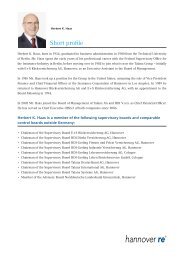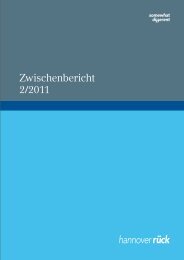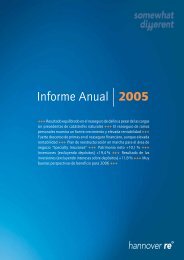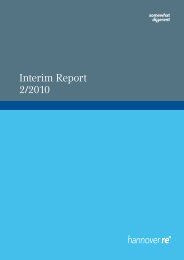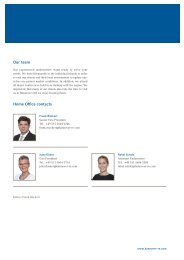Annual Report 2010 - Hannover Re
Annual Report 2010 - Hannover Re
Annual Report 2010 - Hannover Re
You also want an ePaper? Increase the reach of your titles
YUMPU automatically turns print PDFs into web optimized ePapers that Google loves.
of demand and the diversification of the markets, our facultative<br />
portfolio should again generate profitable growth in 2011.<br />
We anticipate that the rate erosion in conventional property<br />
and casualty business will be offset by the writing of niche<br />
segments.<br />
Life and health reinsurance<br />
In the coming years, as in the past, we expect to see a positive<br />
basic direction and further dynamic growth in international<br />
life and health reinsurance business; this can be attributed to<br />
the demographic changes in mature markets, progressive urbanisation<br />
and the ongoing formation of a stable middle class<br />
in emerging markets as well as the professional competition<br />
conducted among the six leading life reinsurers. The high entry<br />
barriers and long-term orientation of life and health reinsurance<br />
continue to act as stabilising structural factors in our<br />
markets.<br />
On a global level the growth recorded in life and health reinsurance<br />
should continue to outpace the comparable growth<br />
on primary markets.<br />
In this context we are seeing a shift in demand for new business<br />
away from developed markets such as the United States,<br />
United Kingdom and Germany towards emerging markets<br />
such as China, India, Brazil and Latin America. This trend assists<br />
internationally positioned life insurers and offers this<br />
group of clients – as multinational insurers – considerable opportunities<br />
going forward.<br />
For <strong>Hannover</strong> Life <strong>Re</strong>, the evolution of our tried and tested<br />
“Five Pillar” model continues to shape the development of our<br />
business; new markets will remain the principal engines of<br />
growth over the coming two to three years. We also see good<br />
potential in the bancassurance sector, especially in emerging<br />
markets.<br />
Our expansionary efforts are concentrated on the United<br />
States, Arab countries and the key emerging markets of Asia<br />
and Latin America.<br />
With other markets such as South Africa, Australia and Bermuda<br />
also picking up on this model and aspiring to regulatory<br />
equivalence, we see the implementation of Solvency II in<br />
2013 as an essentially global model.<br />
Our business opportunities and risks<br />
Non-life reinsurance<br />
Irrespective of the expectations for individual segments and<br />
markets in non-life reinsurance, it should be noted that the<br />
probabilities of occurrence for (natural) catastrophe events in<br />
terms of their number and scale as well as their magnitude for<br />
the insurance industry are subject to considerable fluctuations.<br />
Hence, the total burden of losses in the current financial<br />
year may be significantly higher or lower than catastrophe loss<br />
assumptions based on multi-year trends and averages.<br />
What is more, in numerous lines there is a correlation between<br />
the state of the overall economy and the claims frequency. A<br />
healthy economic climate naturally leads to higher claims frequencies<br />
– for example in the motor and engineering lines. In<br />
credit and surety reinsurance the correlation is inverted: as<br />
insolvency numbers rise, so do loss ratios – but also prices for<br />
reinsurance covers.<br />
General growth stimuli for non-life reinsurance are expected<br />
to come from the more exacting requirements placed on companies’<br />
risk-based capital resources; for them, the transfer of<br />
risk to reinsurers with good ratings offers an economically<br />
attractive alternative.<br />
Life and health reinsurance<br />
The general framework conditions in international life and<br />
health reinsurance can in principle be described as favourable.<br />
In mature insurance markets such as the United States,<br />
Japan, United Kingdom and Germany this assessment is coloured<br />
by the demographic trend, i.e. the ageing of the population,<br />
which is reflected in heightened demand – especially for<br />
annuity and health insurance products.<br />
Management report<br />
The preparations for Solvency II, and in particular the stress<br />
tests performed by the EU (QIS – Quantitative Impact Studies),<br />
have led to a greater risk awareness among European insurers<br />
and highlighted the important role of reinsurance as a means<br />
of risk and capital optimisation. This is especially true of small<br />
and mid-sized insurers, specialty providers and mutual insurance<br />
companies.<br />
Increasing urbanisation in leading emerging markets such as<br />
China, India and Brazil is fostering a rapidly growing middle<br />
class, which to a greater extent than before is clamouring for<br />
insurance solutions designed to protect surviving dependants<br />
and afford individual retirement provision for policyholders.<br />
With this in mind, primary insurers are looking for tailored<br />
reinsurance solutions that support their own capital, liquidity<br />
<strong>Hannover</strong> <strong>Re</strong> Group annual report <strong>2010</strong><br />
Forecast Management report<br />
97



